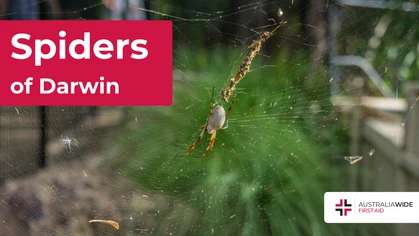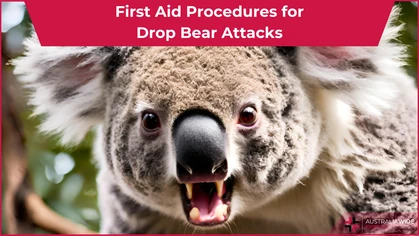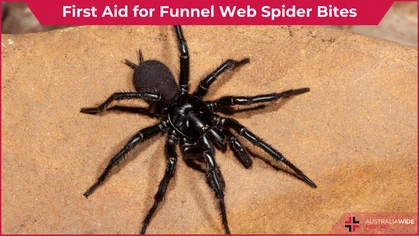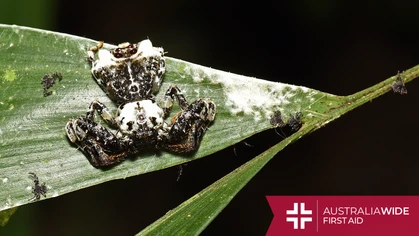First Aid for Animal Bites

Bites and Stings

Here in Australia, it is not only our wildlife that can deliver painful and potentially dangerous bites. In fact, most animal bites in Australia are caused by dogs. Today, we look at the first aid procedures for the most common animal bites in Australia.
In Australia, we are lucky enough to have a diverse range of animals living among us. From the cute and cuddly koalas in the south, to the crocodiles in the north - we have it all! But with this diversity comes a risk of animal bites. This blog post is aimed at providing first aid information for those who may find themselves in the unfortunate situation of being bitten by an Australian animal. It will identify how animal bites happen and how to provide first aid treatment. Our tips and tricks will help you to support your friends and family if you are bitten by an animal, but for more information feel free to check out our First Aid courses we offer.What is an Animal Bite?
An animal bite is a break in the skin that occurs when an animal's teeth puncture the skin. This can happen when you are handling an animal or if the animal is feeling threatened and attacks you. In Australia, there are many different animals that could potentially inflict a bite, including:- Snakes
- Spiders
- Scorpions
- Bees and wasps
- Dogs
- Cats
- Rodents such as rats and mice
- Birds such as emus and cassowaries.
Statistics of Animal Bites in Australia
In Australia, it is estimated that there are between 3000 and 5000 hospitalisations due to animal bites each year. Of these, around 500 require reconstructive surgery. Many Australians experience bee, spider and other insect bites. These are usually not serious and will resolve on their own, so the number of these bites within any given year is unknown. However, some bites from these insects can be more severe and require medical attention, especially if someone is allergic to the animal that bit them. The most common type of animal bite that requires treatment is from a dog, with around two-thirds of bites being from our furry friends. Cats are not too far behind dogs in being the most common animal bites to require treatment and attention - showing that our domesticated animals are at a far higher risk of biting than the more dangerous Australian wildlife!
Dog bites are the most common animal bites in Australia. Dogs can bite when they feel scared, startled, or confused. They may also bite to protect something valuable to them, such as their toys, puppies, or food.
Dog Bites
Dogs are by far the most common type of animal to bite humans in Australia. In fact, around 33% of Australians will suffer a dog bite at some stage in their life. Most dog bites will not result in serious injury, but there is always a risk of infection. It is important to seek medical attention if you think you may have been infected, as dog bites can sometimes lead to complications such as cellulitis. If you are bitten by a dog, it is important to follow these steps:- Apply pressure to the wound with a clean cloth to stem any bleeding.
- Irrigate and clean the wound with saline solution and gauze.
- Once the wound is well irrigated and clean, cover it with a clean, dry dressing and seek medical attention for antibiotics or any other treatment that the doctor sees fit.
- If possible, try to identify the dog that bit you so that it can be quarantined and monitored for rabies (if you are in another country).
Cat Bites
Cats are the second most common type of animal to bite humans in Australia. Around 16% of Australians will suffer a cat bite at some stage in their life. Most cat bites will not result in serious injury, but there is always a risk of infection. It is important to seek medical attention if you think you may have been infected, as cat bites can sometimes lead to complications such as cellulitis. If you are bitten by a cat, it is important to follow these steps:- Apply pressure to the wound with a clean cloth to stem any bleeding.
- Irrigate and clean the wound with saline solution and gauze.
- Once the wound is well irrigated and clean, cover it with a clean, dry dressing and seek medical attention for antibiotics or any other treatment that the doctor sees fit.
Snake Bites
Snake bites are relatively rare in Australia, with around 1000 people being bitten each year. However, they can still be very dangerous, as some snakes are venomous. Most snake bites occur between October and March when snakes are more active. The most common type of snake to bite humans in Australia is the brown snake, followed by the tiger snake and the black snake – all these snakes are dangerous and should be responded to with urgent medical care. Snake bites should always be treated as venomous until proven otherwise by a doctor at a hospital. As such, if you are bitten by a snake, it is important to follow these steps:- Ensure the casualty remains as still as possible to stop the venom from travelling through the body.
- Keep the casualty at rest, and observe and reassure them constantly.
- Follow DRSABCD, call Triple Zero (000) for an ambulance, and be prepared to perform CPR.
- Apply the ‘pressure immobilisation technique’ (PIT):
If the bite site is on a limb, cover it with a wide heavy elastic bandage (10 - 15 cm wide).
Ensure the bandage is firm and tight, so tight you cannot easily slide a finger between the bandage and the skin.
Apply a second heavy elastic bandage. Start from the fingers or toes and wind up the limb as far as possible. Consistent coverage (overlapping half over half) and consistent pressure (firm but not cutting off circulation) are key to an effective PIT. - Immobilise the limb and joints with a splint, or use a sling if the bite site is on an arm. Keep the limb immobilised until the ambulance arrives.
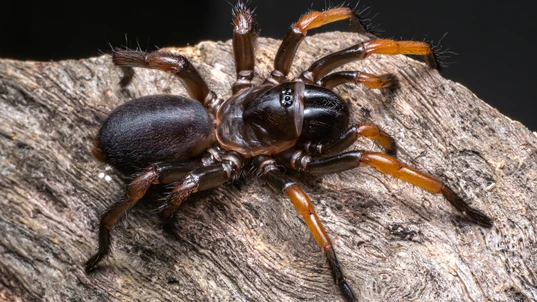
Trapdoor spiders are one such spider in Australia that can deliver a nasty bite. Males have been known to rear up when startled, and their bite can cause localised pain and swelling.
Spider Bites
Although most spiders in Australia are not venomous, there are a few that can cause serious harm. The two most dangerous spiders in Australia are the Funnel-web spider and the Redback spider.Funnel-web Spider
If you are bitten by a Funnel-web spider, it is important to follow these steps:- Ensure the casualty remains as still as possible to stop the venom from travelling through the body.
- Keep the casualty at rest, and observe and reassure them constantly.
- Follow DRSABCD, call Triple Zero (000) for an ambulance, and be prepared to perform CPR.
- Apply the ‘pressure immobilisation technique’ (PIT):
If the bite site is on a limb, cover it with a wide heavy elastic bandage (10 - 15 cm wide).
Ensure the bandage is firm and tight, so tight you cannot easily slide a finger between the bandage and the skin.
Apply a second heavy elastic bandage. Start from the fingers or toes and wind up the limb as far as possible. Consistent coverage (overlapping half over half) and consistent pressure (firm but not cutting off circulation) are key to an effective PIT. - Immobilise the limb and joints with a splint, or use a sling if the bite site is on an arm. Keep the limb immobilised until the ambulance arrives.
Redback Spider
If you are bitten by a Redback spider, it is important to follow these steps:- Reassure the casualty and keep them under constant observation.
- Apply a cold compress to the bite site for periods of up to 20 minutes to lessen the pain.
- If the casualty is a young child (under 8 years), a pregnant woman, or if they exhibit any signs of deterioration, follow the basic life support guidelines per DRSABCD and call Triple Zero (000) for an ambulance.
- DO NOT use the Pressure Immobilisation Technique, as the venom moves slowly and this will just worsen the pain.
- If the pain persists or you are worried about your symptoms, it is best to seek medical attention.

Though hamsters (like the one in this image), have not been introduced in Australia, Australians are not exempt from rodent bites. For instance, mouse bites are particularly common among farmers in regional areas.
Rodent Bites
Rodent bites are relatively rare in Australia, but they can still occur. The most common type of rodent to bite humans is the rat, followed by the mouse and the guinea pig. Most rodent bites will not result in serious injury, but there is always a risk of infection. It is important to seek medical attention if you think you may have been infected. If you are bitten by a rodent, it is important to follow these steps:- Apply pressure to the wound with a clean cloth to stem any bleeding.
- Irrigate and clean the wound with saline solution and gauze.
- Once the wound is well irrigated and clean, cover it with a clean, dry dressing and seek medical attention for antibiotics or any other treatment that the doctor sees fit.
- If possible, try to identify the rodent that bit you so that it can be quarantined and monitored for diseases.
Signs and Symptoms of an Animal Bite
Animal bites can range from being a very minor injury to causing serious damage. The severity of the bite will depend on many factors, such as:- The size and weight of the animal
- The type of teeth the animal has
- How long the animal held onto the skin
- Whether the animal's teeth broke the skin or not
- What parts of the body were bitten
- Pain
- Swelling
- Redness
- Bruising
- Bleeding
- Infection
Complications of Animal Bites
Animal bites can lead to serious health complications, such as:Infection
When an animal's teeth break the skin, there is a risk of infection. This is because the animal's mouth is full of bacteria which can enter the body through the wound. The risk of infection is increased if the wound is not cleaned and treated properly.Injury
Animal bites can cause serious injury, depending on the size and weight of the animal, as well as the type of teeth the animal has. Bites from larger animals or those with sharp teeth are more likely to cause serious damage.Tetanus
There is also a risk of developing tetanus if you are bitten by an animal. Tetanus is a serious bacterial infection that can cause muscle spasms, paralysis and even death. It is important to ensure that you are up-to-date with your tetanus vaccinations to reduce the risk of developing this infection.Preventing Animal Bites
The best way to prevent animal bites is to be aware of the risks and take precautions. Some tips that may help include:- Avoid handling animals that you do not know. If you must handle an animal, make sure you wash your hands afterwards.
- Do not approach wild animals, even if they look tame.
- Do not play with or disturb animals that are sleeping or eating.
- If you see an animal behaving strangely, it is best to keep your distance and contact the relevant authorities.
- Always supervise children around animals.
- Spay or neuter your pets to help reduce aggression.
- Train your pets to obey commands and socialise them from a young age.
- Do not leave food or trash where animals can access it as this may attract them to your property.
Final Thoughts
Taking a first aid course is the best way to be prepared for any emergency, including animal bites. First aid courses teach you how to deal with different types of injuries and how to provide care in an emergency situation. They also give you the confidence to know that you are able to help if someone is injured. If you would like to learn more about first aid or take a course, please visit our website or contact us today.
Originally published at
https://www.australiawidefirstaid.com.au/resources/first-aid-for-animal-bites
as part of the Australia Wide First Aid Articles Library
